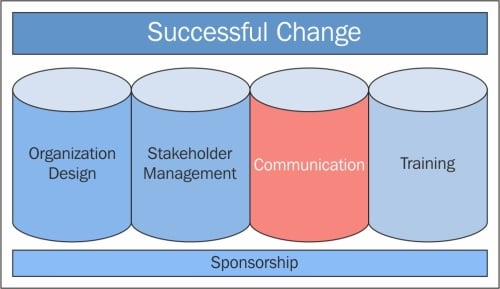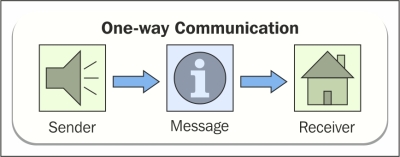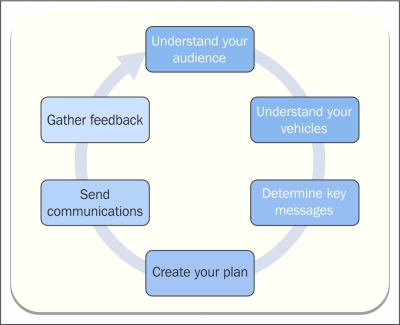Chapter 5. Communicating the Change
By the end of this chapter, you will be able to:
Define different styles of communicating
Conduct an audience analysis as an input to your communication plan
Conduct a vehicle analysis to determine the best methods for communicating
Build feedback methods into your communication plan
Create a communication plan
Improve your ability to write change communication
Now that we have identified our key stakeholders, it's time to develop a plan for communicating with them.
Throughout this chapter, the major theme you will hear over and over is: "Communicate early. Communicate often. When you think you've communicated enough, communicate some more."
I cannot stress enough the importance of communication. Time and again, I have seen situations where people assume they have successfully communicated a message, only to discover (usually too late) that the communication failed.
This brings me to another major theme you will hear both in this chapter and the next chapter on...
The importance of two-way communication
In the early days of communication studies, there was a communication style known as Magic Bullet Theory or Hypodermic Needle Theory. According to this theory, if you send a message to your audience, you can assume that they received and understood it. Essentially, the message is the "bullet" and it's magic because it hits its mark every time.
You already know how I feel about assuming.
Although this theory has been disproved multiple times over the years, many organizations still use this communication style. Consider the common example of the "System outage" e-mail. The IT department needs to take down a computer system for maintenance, so they send out a mass e-mail letting everyone know that the system will be unavailable between 10 pm and 11 pm on Friday night. With that one e-mail, the entire communication plan is complete.
On Friday night, the IT team performs the system maintenance.
Inevitably, on Monday morning, there will be at least one e-mail...
Push versus pull communication
A part of ensuring that your audience receives your communication is choosing the best method for sending it. These methods fall into two broad categories: push communication and pull communication.
Push communication is communication that you send to the audience. The audience has no choice in the matter; they simply receive the message. Examples of push communication are e-mail, voicemail, and paper newsletters placed on each person's desk.
Pull communication is communication that the audience must actively seek and obtain. The audience has complete control over whether or not they receive the communication. Examples of pull communication include online employee portals, search engines, and a pile of newsletters on a table in the break room that employees can choose to read. Live communications, such as meetings and conference calls, also fall into this category, as people can choose whether or not to attend.
Your communication plan should contain a combination...
Breaking through the noise
The previous example brings us to an issue that many change projects face: breaking through the "noise" of too much communication. If the average employee spends each day sorting through dozens of e-mails, a handful of voicemails, hours of meetings, and quick updates in the hall. How do you get them to pay attention to your communication?
We already talked about one method in Chapter 2, Establishing the Framework for Change:
Remember to partner Corporate Communications and other project teams to coordinate the timing of communication. Try to stagger communication on different topics so that recipients can focus on one set of messages at a time.
Another tip comes from Chapter 3, Building Sponsorship for the Change:
Note
Tip
Utilize your sponsors. Your audience is more likely to pay attention to a message coming from someone they personally know and respect, than they are to a communication sent from someone they don't know or a generic project communications e-mail...
Conducting an audience analysis
You laid the groundwork for your audience analysis in Chapter 4, Managing Your Stakeholders, when you conducted your stakeholder analysis. Begin by listing all of the stakeholders (both groups and individuals) that you identified in your stakeholder analysis. For each group, you will need to consider the following points:
How many people are in the group? The size of the group will impact how you communicate with them. For example, if you are dealing with an individual or small group, you may decide to have in-person meetings. If it's a large group, on the other hand, you may need to stick to e-mail or other less direct methods.
Where are they located? A group that is geographically diverse can offer unique communication challenges. For example, instead of holding an employee meeting in a conference room, you may need to set up a teleconference. It might not be possible to provide hard copies of newsletters to people in other locations, so you may rely more...
Conducting a vehicle analysis
The next step in preparing your communication plan is conducting a vehicle analysis. In a communication plan, the vehicle is the method you use to send your communication. Examples of vehicles include e-mail, voicemail, presentations, and videos.
Conducting a vehicle analysis helps you to determine which communication vehicles already exist in your organization, the new communication vehicles you need to create, and which communication vehicles work best for each audience. Review the following template, then continue reading for the steps to complete each column:
The steps to completing the vehicle analysis are as follows:
Communication messages by project phase
There is an endless list of messages you may want to send about your change project. In this section, I have listed three or four key messages for each project phase that you don't want to forget. As you create your communication plan, use these as a starting point for developing your full list of messages.
Because this book is focused on IT projects, I am using the basic phases of a system implementation: Analyze, Design, Build, Test, Implement, and Maintain. Many of the messages would be the same regardless of the type of change you are implementing.
I refer to the change curve throughout this section. As a reminder, this is what the change curve looks like:
During this phase, most people are still in the Unaware stage on the change curve. All you need to do is begin to give them basic information about the change project. Keep your messages simple and to the point.
Often at this phase in the project, even the team isn't sure of exact dates and...
As we discussed earlier, it is important for communication to be a two-way dialog between you and your audience. You can increase the chance that your stakeholders will communicate with you by purposely setting up feedback channels. Make sure these channels are easy for the audience to use and are monitored by someone on the project team on a regular basis.
There are dozens of ways to gather feedback. Here are a few ideas to get you started.
One of the first things I do when I join a project is set up a dedicated e-mail address (<projectname@company.com>). I use this e-mail address to send official project communication. I also put this e-mail address at the bottom of every project communication and form, and ask people to use it for all questions and comments. This serves three purposes. First, by having a dedicated e-mail address, there is less chance that questions about the project will get lost among my other work e-mails...
Creating the communication plan
You have now conducted an audience analysis, completed a vehicle analysis, identified key messages for each project phase, and determined how you will gather feedback. It is time to create the complete communication plan for your change project.
Note
Tip
Remember that this communication plan is a living document. You will update it throughout the project. Never hesitate to make changes that will improve your ability to communicate more effectively with your stakeholders.
Take a minute to review the following template before reading a description of each column:
An explanation of each column and how to fill it in is described in detail as follows:
Message: Gather the messages you identified in the Key messages column of your audience analysis, as well as the key messages for each project phase, and enter them in the Message column. Add any other messages you know you will need...
Writing good communication
Writing good communication is a skill that requires a lot of practice. As you write about the change, think about who your audience is, what they want to know, and what you need them to do.
Note
Tip
I also strongly recommend that you always have someone else review your communication before you send anything out. No matter how long you've been writing professional communication, it is always a good idea to have another person read your work before you hit "send."
The following are ten tips and tricks to help you write strong communication:
Don't assume. I'm starting with one of my favorite pieces of advice. You can never assume that your audience knows what you know. Be clear, explain all key concepts, and include all relevant details.
Keep it simple. Some people think that the more complex a communication is, the more impressive it seems. All a complex message will do is confuse your audience. Keep the message simple and concise.
Don't use jargon. Avoid jargon,...
Communicating a change is an ongoing activity. In this chapter, you have learned how to:
Conduct an audience analysis
Conduct a vehicle analysis
Identify key messages by project phase
Gather feedback
Create a communication plan
Write good communication messages
Instead of thinking about communication as a path that you follow from the beginning to end, though I encourage you to think of it as a continuous cycle.
You're almost there! In the next chapter, we will explore the last major topic in this book: training.
 The rest of the chapter is locked
The rest of the chapter is locked
Get unlimited access to 7000+ expert-authored eBooks and videos courses covering every tech area you can think of




































































